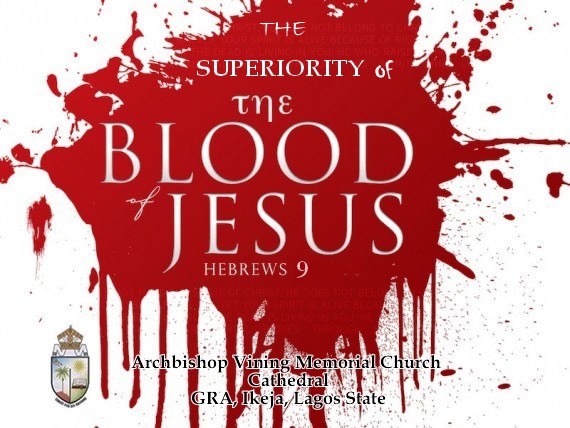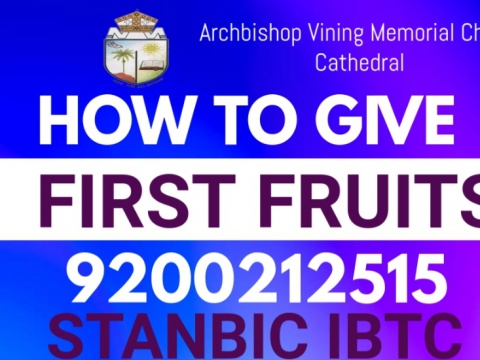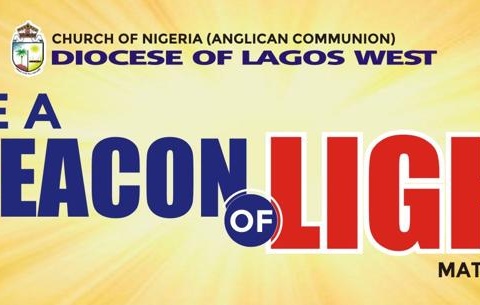- Have any questions?
- +234 8111114588
- info@avmcc.org.ng
THE SUPERIORITY OF THE BLOOD OF JESUS CHRIST – HEB.9
Bulletin for 7th April, 2019
April 8, 2019Bulletin for Palm Sunday, 2019
April 11, 2019Aim: To encourage Christians not to loose hope but trust the power in the Blood of Jesus Christ
to save and deliver.
INTRODUCTION
In our previous study, we learnt that the first Covenant became obsolete and was fading away, and that paved the way for a new and better Covenant that would be effected only by the precious Blood of Jesus Christ. The blood of animal offered by the high priest on yearly basis would not be necessary any longer,
because Jesus Christ has shed his Blood on the cross at Calvary.
- Description of the Old Tabernacle (Heb. 9:1-5).
- The tabernacle ordained by the Old Covenant was planned by God, but planned for an earthly service.
- The tabernacle was a tent 45 feet long, 15 feet wide, and 15 feet high, divided into two rooms. The larger room (the first part) was a 15 foot by 30 foot “holy place.” Behind the second veil was the smaller room of a 15 foot by 15 foot, called the Holiest of All.
- The Lampstand with a middle stem and six branches stood in the first part and was of an unspecified size, made of pure gold; it provided the only light for the tabernacle (Exodus 25:31-40).
- The table sat in the first part and was made of acacia wood covered with gold, 3 feet long, 1½ feet wide, and 2 feet 3 inches high. It held twelve loaves of showbread, each representing God’s fellowship with the twelve tribes of Israel (Exodus 25:23-30).
- The sanctuary refers to the first part, known as the “holy place.” A veil (a thick curtain) separated the first part from the Holiest of All, also known as the “holy of holies” (Exodus 26:31-33).
- The golden altar of incense was made of acacia wood covered with gold, 1½ feet square, and 3 feet high. It stood at the veil before the “holy of holies,” and was used to burn incense (Exodus 30:1-8).
- The ark of the covenant stood inside the Holiest of All, and was a chest made of acacia wood covered with gold, 3¾ feet long, 2¼ feet wide, and 2¼ feet high, with rings for polls along it’s side by which it would be carried (Exodus 25:10-22).
- Inside the ark was the golden pot that had the manna (Exodus 16:33), Aaron’s rod that budded (Numbers 17:6-11), and the tablets of the covenant (Exodus 25:16).
- The manna reminded Israel of God’s provision and their ungratefulness. Aaron’s rod reminded them of their rebellion against God’s authority. The tablets of the covenant reminded them of their failure to keep the Ten Commandments and rest of the law.
- The Mercy Seat was the ornate “lid” for the ark of the covenant, made with the designs of cherubim upon it; the blood of sacrifice was sprinkled upon it for the forgiveness of Israel’s sin on the Day of Atonement (Exodus 25:17-22).
- As God looked down into the ark, He saw the symbols of Israel’s sin, rebellion and failure. But when the blood of sacrifice was applied to the mercy seat, His sight of the sin of Israel was covered by the blood of sacrifice.
- (Heb 9:6-7) Priestly service in the tabernacle under the Old Covenant
- The priests, as appointed, went daily into the “holy place” to perform priestly functions such as tending the lampstand and replacing the showbread.
- The “holy of holies” was entered only once a year by the high priest alone, on the Day of Atonement.
- His entrance into the second part was not for fellowship, but only for atonement, first for his own sin, then for the sins of his people.
- Access into the Holiest of All was thus severely restricted, and even when someone could enter, it wasn’t for real fellowship with God.
- The ancient Jewish Rabbis wrote of how the high priest would not prolong his prayer in the Holy of Holies on the Day of Atonement, because it might make the people think he had been killed. When he came out, he threw a party for all his friends, because he had emerged safely from the presence of God.
- Sins of ignorance were the specific aim of the Day of Atonement. It was assumed that known sin would be taken care of through the regular sin offerings and the daily sacrifices.
- In this respect, Jesus’ work is far greater than the work done on the Day of Atonement. Jesus’ work on the cross is sufficient to atone for both the sins we do in ignorance and sins that we know.
- (Heb 9:8-10) The Holy Spirit gives understanding regarding the priestly service under the Old Covenant.
- The old had to pass away before God’s new way could be revealed.
- The tabernacle itself and all that the Old Covenant represented were suggestive of deeper truths, parables of the New Covenant.
- The priestly service performed in the time of old did not make even the priests offering those sacrifices perfect and clean.
- If the cleansing is incomplete for the priest, how much more for the person the priest worked on behalf of!
- The weakness of the priestly service under the Old Covenant was its inability to address the need for inner transformation in man.
- Features of the New Covenant described.
- (Heb 9:11) The superior sanctuary of the New Covenant.
- Jesus, as our High Priest, ministers in a superior sanctuary – the very throne room of God, a place greater than anything human hands could make.
- (Heb 9:12-15) The superior sacrifice of the New Covenant.
- The blood of goats and calves was sufficient for a temporary covering of sin; but only a perfect sacrifice could obtain eternal redemption.
- Jesus’ sacrifice was superior in that it was perfect, voluntary, rational, and motivated by love.
- If these imperfect sacrifices were received as sufficient by Israel, how much more should they regard the ultimate sufficiency of the perfect sacrifice?
- The ashes of a heifer refer to the remains of a burnt offering that was preserved, and sprinkled in the laver of washing to provide water suitable for ceremonial cleansing (Numbers 19:1-10).
- This was a shadow, fulfilled and done away with when Jesus offered a perfect cleansing; there is no value in “holy water” used by some churches today.
iii. Reportedly, there is a search for a “red heifer” that can be sacrificed, and its ashes used as part or a restoration of priestly functions for a rebuilt temple in Jerusalem.
- The sacrifice of Jesus is sufficient to even restore our damaged conscience.
- Our conscience is a wonderful tool from God, although not perfect.
– Our conscience can be seared (1 Timothy 4:2).
– Our conscience can be defiled (Titus 1:15).
– Our conscience can be evil (Hebrews 10:22).
- Jesus’ work as a Mediator is fundamentally accomplished at His death. His heavenly work of mediation looks back to that perfect sacrifice.
- Jesus’ payment on the cross accomplished redemption for those under the first covenant. Every sacrifice for sin made in faith under the Mosaic command was an IOU cashed in at the cross.
- (Heb 9:16-22) The necessity of Jesus’ death.
- A testament only takes effect when the person making the testament dies. Therefore Jesus had to die for the testament – the covenant – to take effect.
- The word that has been used for covenant is actually the word testament. The idea is essentially the same as a covenant, except that it is dictated by one party, not negotiated upon by two parties.
- Clearly, death was necessary to the Old Covenant. Virtually every part of the sacrificial system under the Law of Moses was touched by blood in some way or another.
- An important principle is stated: Without shedding of blood there is no remission of sin.
- Modern people think that sin is remitted (forgiven) by time, by our good works, by our decent lives, or by simply death.
- But there is no forgiveness without the shedding of blood, and there is no perfect forgiveness without a perfect sacrifice.
- (Heb 9:23-28) The perfect sanctuary receives a perfect sacrifice.
- It was acceptable for the copies of the things in the heavens in the earthly sanctuary to be “purified” with imperfect sacrifices. But the heavenly things themselves could only be purified with a perfect offering.
- Jesus’ sacrifice was made on earth, but it is the basis for His continuing work as our mediator and High Priest in heaven.
- Jesus’ ministry for us continues in heaven, but not in the sense of continuing to atone for our sin. His ministry continues for us in intercession and defending us against the accuser of God’s people (Revelation 12:10). But it does not continue in the sense that He should offer Himself often. His sacrifice was once-for-all, and perfectly satisfied God’s holy justice.
- If the sacrifice of Jesus were not perfect, then it would have to be continual and constant. Imperfect sacrifices must be repeated continually but a perfect sacrifice can be made once for all time.
- Just as certainly as we die once and then face judgment, so Jesus only had to die once to bear our sin.
Note: It is important to note that the principle of it is appointed for men to die once is not an absolute principle. There are some unique, remarkable exceptions.
– Enoch (Genesis 5:24) and Elijah (2 Kings 2:11) never tasted death.
– Several people in the Bible were raised from the dead, and therefore died twice (1 Kings 17:22; 2 Kings 13:20-21, Matthew 9:25, John 11:43-44, Acts 20:9-11),
– Those taken in the rapture (1 Thessalonians 4:17) will never die once. Yet these remarkable, unique exceptions do not deny the principle; they are exceptions that prove the rule.
- The focus of Jesus’ first coming was to deal with sin through His atoning sacrifice. Having dealt with the problem (sin) perfectly, He comes again for the salvation of His people, who eagerly wait for Him.
Ministering in the Sanctuary under the Old and New Covenants Compared:
| S/N | OLD COVENANT | NEW COVENANT |
| 1. | It was an earthly Sanctuary (vs. 1) | It is heavenly (vs. 11) |
| 2. | A prototype of something greater (vs. 2-5) | The very throne of God |
| 3. | Inaccessible to the people (vs. 6-7) | Accessible to the people |
| 4. | It was temporary (vs. 8) | It is eternal (vs. 15) |
| 5. | External (ceremonial cleansing) (vs. 9-10) | Internal (conscience cleansing)
(vs. 13-14) |
| 6. | Ineffective to deal with sin (animal blood) | Effective to deal with sin (vs. 12-15) |
| 7. | Repeated sacrifices | One sacrifice |
| 8. | Covering sin | Putting away sin |
| 9. | Only for Israel | All sinners |
| 10 | Entering / leaving the holy of hollies every year | Entering heaven and remains there |
| 11. | Came out to bless the people | Coming to take his people to heaven (John 14:1ff) |
Questions
- Why do some Christians still believe in shedding animal blood for solution to their problems? (Rom.12:1-2; 2Cor.5:17)
- What made the sacrifice of Jesus Christ a perfect sacrifice? (Heb. 9:13&14; Titus 2:14; 1Pet. 3:18)
- Mention some benefits obtainable through the Blood of Jesus Christ (1 Pet.1:18-19; Heb. 10:19ff; Eph. 1:7; 2:13; 1 John 1:7; Rev.12:11; Rom.5:9)
- Share your personal testimony about what the Blood of Jesus Christ has done in your life.
CONCLUSION
The Blood of Jesus Christ is the best alternative therapy. It is powerful in curing all manner of disease and sickness (Acts 10:38). Interestingly, the Blood of Jesus Christ has “no side effect” and “no expiry date”. For the Blood of Jesus Christ to work for you, you must accept Him as your Lord and Saviour, and believe in the efficacy of His blood for your healing and deliverance.
Memory Verse: “How much more shall the blood of Christ, who through the eternal Spirit offered himself without spot to God, purge your conscience from dead works to serve the living God?” – Heb 9:14 KJV




